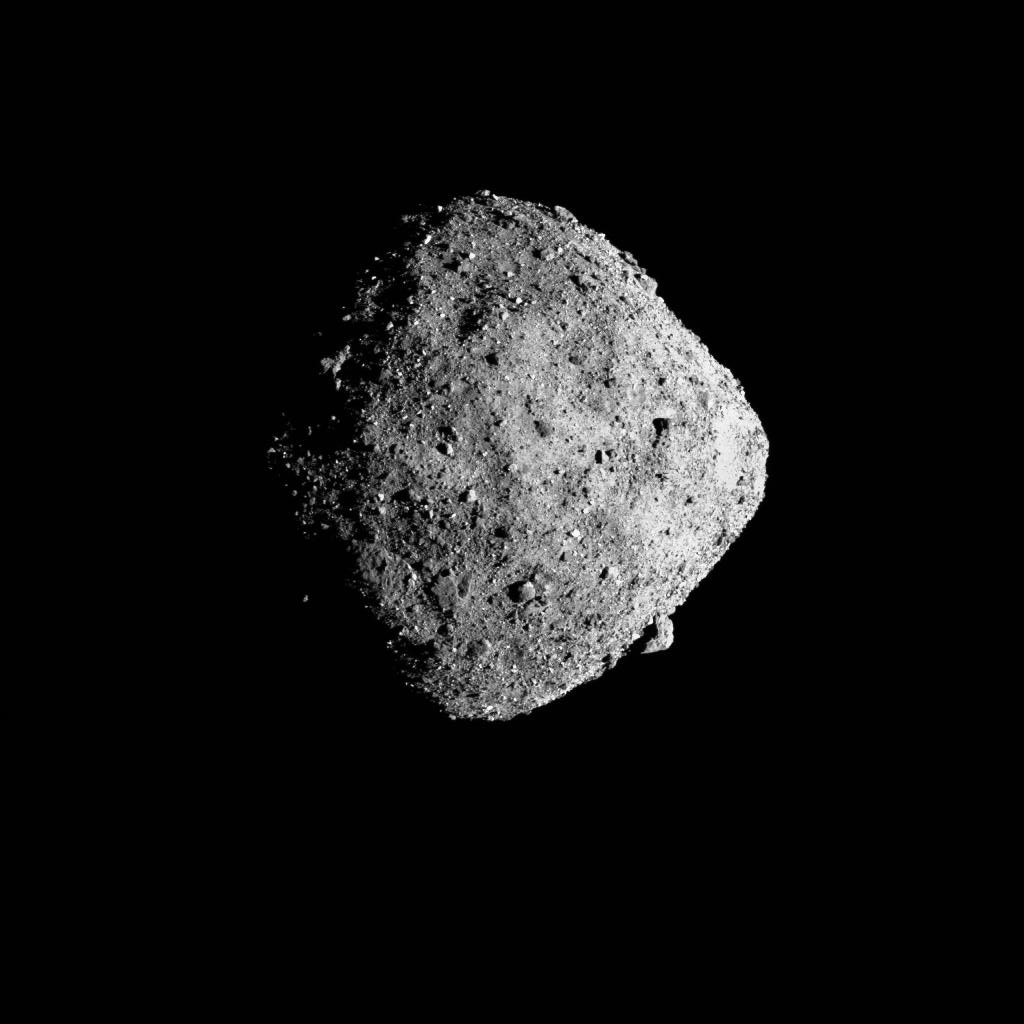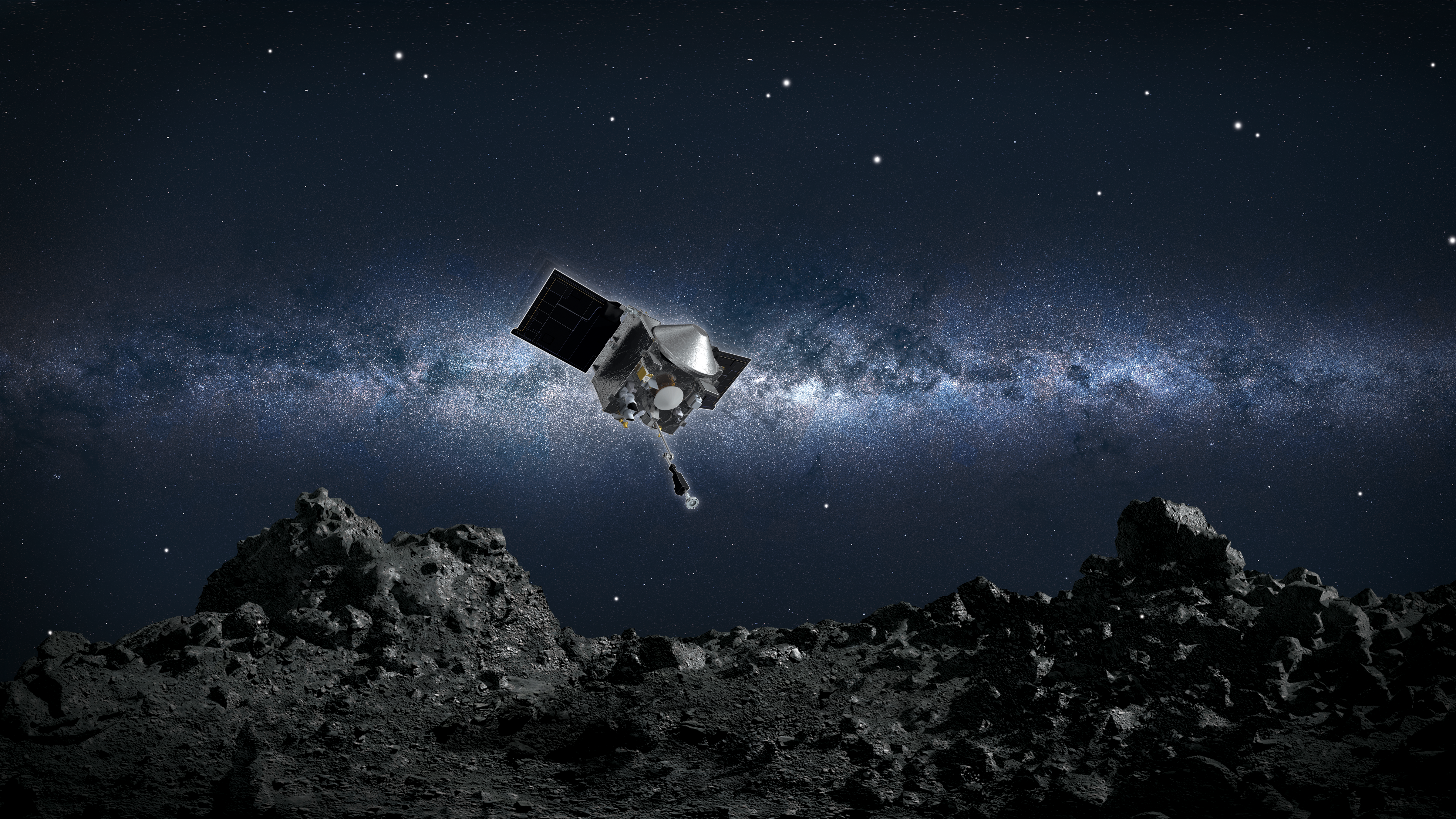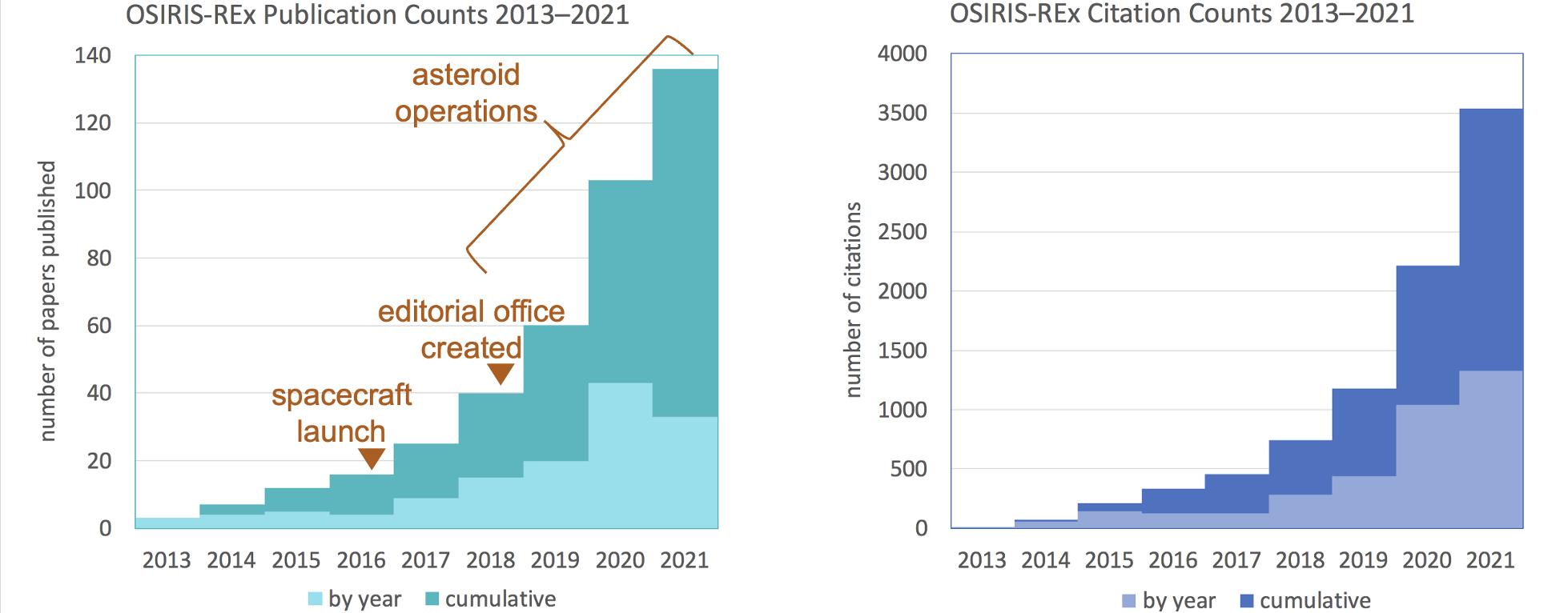Large-scale collaborative scientific endeavors, such as space missions and Earth observatories, typically have a press office that strategizes and coordinates communication with the public. The same kind of internal coordination is not necessarily applied to communication with the scientific community—that is, via scholarly publications—although peer review and journal production provide external quality control. Issues that sometimes plague publications from large, complex team efforts—such as error propagation, duplication, unaddressed contradictions, and scooping or stove-piping of results—could be mitigated by internal review of manuscripts, and a strategic approach could optimize the impact of the published papers. A principal investigator (PI) or project lead may be able to provide the necessary internal perspective, but they are likely to be burdened by competing demands.
Here we describe how NASA’s OSIRIS-REx mission approached this problem and what we have learned from managing manuscripts produced by the scientists and engineers of varying priorities, specialties, geographic locations, and career stages that compose the mission team.
OSIRIS-REx (which stands for Origins, Spectral Interpretation, Resource Identification, and Security–Regolith Explorer1) is the first U.S. mission to sample an asteroid.2,3 The spacecraft, equipped with a sophisticated payload of cameras, spectrometers, and a laser altimeter, arrived at its target, the near-Earth asteroid Bennu, in 2018 (Figure 1). It spent the next 3 years observing Bennu from close range. This period involved a series of intense operational and analytical cadences to characterize the landscape, select a viable touchdown site, and safely acquire a sample of loose rocks and dust (or regolith) from the surface (Figure 2).


Simultaneously, the team—many of whom were involved in both operations and science—needed to produce timely and impactful manuscripts within a finite funding period. To support this need, the mission implemented the following measures:
1. The establishment of an editorial office to manage publications. An editor with a relevant scientific background was recruited for this purpose, working closely with the PI and other scientific leadership on the mission to coordinate and review manuscripts.
2. A publication plan, co-developed with authors before the asteroid encounter, that defined the manuscripts to be produced during the funded period. The plan indicated which manuscripts were associated with the data products required by the sponsor, making it possible to track the fulfillment of requirements via peer-reviewed publications. The plan was also used to justify co-investigator budgets.
Of course, a plan made before the acquisition of data must be able to evolve, and this was especially the case for OSIRIS-REx, which encountered several scientific surprises in its exploration of asteroid Bennu—including, for example, an unexpectedly rocky surface that periodically ejects small particles into space.4,5 Authors were therefore able to propose revisions and additions to the plan as the mission progressed. The editorial office coordinated the review of these proposals by mission leadership and kept the plan updated with approved changes.
3. A dedicated review step by the editorial office before journal submission that checked manuscripts for appropriate cross-referencing, co-authorship, consistency, clarity, mechanics, and style. This step additionally involved evaluating the suitability of the paper for its target journal and tailoring it or making alternative recommendations as needed. The editorial office also reviewed manuscripts after revision in response to peer review, before resubmission to the journal, to recheck for consistency and make any updates necessitated by the progress of other papers.
4. A publication guide for authors, which outlined the manuscript proposal and review processes mentioned above; provided a reference for mission style, terminology, phases, and important locations and dates; and included an appendix of foundational references underlying the mission design, instruments, observations, and key findings as they developed.
5. A weekly email update to the mission team on the progress of manuscripts in internal and external review. This kept the team briefed on one another’s activities and offered the opportunity to highlight successes. It also included recent related publications from outside the mission to help authors stay on top of emerging literature in the field.
Together, these measures helped to identify collaboration opportunities, address potential conflicts, strategically coordinate the timing and content of manuscripts, and verify mission success.
Our ability to assess the efficacy of this internal publication management approach is limited without a “control” version of the mission with which to compare outcomes. Nevertheless, the numerous papers published by the mission during asteroid proximity operations (Figure 3)—including 3 special issues, 2 of which were in the Nature and Science families, respectively—point to high productivity and quality. The mission produced its highest yearly count of manuscripts in 2020—the same year that the COVID-19 pandemic emerged and the team was occupied with rehearsing and performing the critical sample collection maneuver.

The OSIRIS-REx spacecraft will deliver the asteroid sample to Earth in September 2023. At this point, a 2-year period of concentrated, globally coordinated laboratory analysis will commence, again accompanied by an ambitious and contemporaneous publication effort.
Below, we summarize the takeaways from asteroid operations, which will continue to guide the mission through sample analysis and may be beneficial for other large collaborations:
- When planning the project, allocate resources for dedicated personnel to provide editorial support and facilitate internal review.
- Plan manuscripts in advance of data collection, but build in flexibility by establishing a process to revise the plan.
- Map planned manuscripts to anticipated data products and sponsor requirements.
- Review manuscripts with an eye toward how they relate to one another.
- Regularly and centrally communicate publication progress to the team and sponsor.
Acknowledgments
This material is based upon work supported by NASA under Contract NNM10AA11C issued through the New Frontiers Program. Wolner, Connolly, and Lauretta are respectively the Chief Editor, Mission Sample Scientist, and Principal Investigator of the OSIRIS-REx mission. The mission’s publication record is the result of the efforts of the entire OSIRIS-REx team.
References and Links
- https://www.asteroidmission.org/
- Lauretta DS, Adam CD, Allen AJ, et al. Spacecraft sample collection and subsurface excavation of asteroid (101955) Bennu. Science. 2022;377:285–291. https://doi.org/10.1126/science.abm1018
- Lauretta DS, May B, Bennett CA, et al. Bennu 3-D: anatomy of an asteroid. London Stereoscopic Company/University of Arizona Press; 2023.
- Wolner CWV, Hergenrother CW, Lauretta DS. (2020). Up close with an active asteroid. Eos. 2020;101. https://doi.org/10.1029/2020EO148582
- Lauretta DS, DellaGiustina DN, Bennett CA, et al. The unexpected surface of asteroid (101955) Bennu. Nature. 2019;68:55–60. https://doi.org/10.1038/s41586-019-1033-6
CWV Wolner (https://orcid.org/0000-0001-5490-0723) is with the Lunar and Planetary Laboratory, University of Arizona, Tucson, AZ. HC Connolly, Jr (https://orcid.org/0000-0002-1803-5098) is with the Lunar and Planetary Laboratory, University of Arizona, Tucson, AZ; the Department of Geology, Rowan University, Glassboro, NJ; and the Department of Earth and Planetary Science, American Museum of Natural History, New York, NY. DS Lauretta (https://orcid.org/0000-0002-2597-5950) is with the Lunar and Planetary Laboratory, University of Arizona, Tucson, AZ, and the Department of Earth and Planetary Science, American Museum of Natural History, New York, NY.
Opinions expressed are those of the authors and do not necessarily reflect the opinions or policies of the Council of Science Editors or the Editorial Board of Science Editor.
